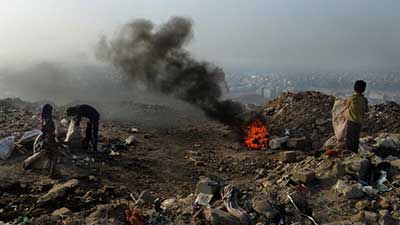Date: 27/12/2022
Relevance: GS-3: Conservation, environmental pollution and degradation, environmental impact assessment Disaster and disaster management.
Key Phrases: Global Methane Pledge, 6th Assessment Report Of The Intergovernmental Panel On Climate Change, Survival Emissions, Enteric Fermentation, Paddy Cultivation, Global Pool Of Enteric Methane.
Why in News?
- India kept away from the UK-led agreement on deforestation and refused to sign the ‘Global Methane Pledge’which is a proposal of the US and the EU to target a 30 percent reduction in global methane emissions by 2030 over 2020 emission levels.
- The government recently gave a detailed explanation to the Parliament why it refused to sign the methane pledge.
What is the Global Methane Pledge?
- The Global Methane Pledge was launched at COP26 in November 2021 to catalyse action to reduce methane emissions.
- Led by the United States and the European Union, the Pledge now has 111 country participants who together are responsible for 45% of global human-caused methane emissions.
- By joining the Pledge, countries commit to work together in order to collectively reduce methane emissions by at least 30% below 2020 levels by 2030.
Reasons Behind Strong Stance of the Indian Government Against the Methane Pledge:
- Methane emissions are survival emissions in India:
- Fundamentally methane emissions are ‘survival’ emissions and not ‘luxury’ emissions, as in the case of the West.
- The two predominant sources of methane emissions in India are:
- enteric fermentation (methane from the intestines of animals).
- paddy cultivation (from standing water).
- These emissions result from agricultural activities of small, marginal, and medium farmers across India, whose livelihood stands threatened by the aforesaid pledge.
- In addition to impacting farmers’ income, this can impact agricultural production, especially that of paddy. India is one of the largest producers and exporters of rice.
- In contrast, agriculture in developed countries is dominated by industrial agriculture.
- Therefore, this pledge also has the potential to affect India’s trade and economic prospects.
- Agriculture not included in India’s emission intensity target:
- The government has pointed out that agriculture was not included in the emission intensity target as per India’s pre-2020 voluntary commitments.
- Shifting of CO2 reduction burden to methane reduction:
- As per the 6th Assessment Report of the Intergovernmental Panel on Climate Change, the predominant gas responsible for climate change is CO2 which has a lifetime of 100-1,000 years.
- This pledge shifts the CO2 reduction burden to methane reduction, which has a lifetime of just 12 years.
- Low global contribution to methane emissions by the Indian livestock:
- Furthermore, India has the largest cattle population in the world, which is a source of livelihood for a large section of the population.
- The contribution of Indian livestock to a global pool of enteric methane is very low, as Indian livestock utilises large volumes of agricultural by-products and unconventional feed material.
- Methane Pledge outside the ambit of the UNFCCC and Paris Agreement:
- The government has cited that while India is a party to the United Nations Framework Convention on Climate Change (UNFCCC) and the Paris Agreement, the Methane Pledge is outside the ambit of the UNFCCC and its Paris Agreement.
- Indian Efforts Towards Methane Emission Reduction: National
Innovations in Climate Resilient Agriculture (NICRA) project by Indian
Council for Agricultural Research (ICAR) has developed several technologies
with the potential to mitigate methane emissions.
- System for Rice Intensification: It has the potential to enhance rice yield from 36-49 percent with about 22-35 percent less water than conventional transplanted rice.
- Direct Seeded Rice: It reduces methane emissions as it does not involve raising nurseries, puddling, and transplanting. Unlike transplanted paddy cultivation, standing water is not maintained in this system.
- Crop Diversification Programme: Methane emissions are avoided due to the diversion of paddy to alternate crops like pulses, oilseeds, maize, cotton, and agro-forestry.
System of Rice Intensification:
- Under SRI paddy fields are not flooded but kept moist during vegetative phase. Later only one inch of water is maintained. SRI requires only about half as much water as normally applied in irrigated rice.
- SRI Paddy Cultivation involves less expenditure and gives more yields. Thus, it is beneficial for small and marginal farmers.
- In SRI paddy cultivation, less quantity of seeds - 2 kg / acre is required. Hence, fewer plants per unit area (25 x 25 cm) whereas mainstream chemical-intensive paddy cultivation requires 20 kg seed per acre. (1 acre= approx 0.4 ha).
Benefits of SRI:
- Higher yields - Both grain and straw
- Reduced duration (by 10 days)
- Lesser chemical inputs
- Less water requirement
- Less chaffy grain %
- Grain weight increased without change in grain size
- Higher head rice recovery
- Withstand cyclonic gales
- Cold tolerance
- Soil health improves through biological activity
Disadvantages
- Higher labour costs in the initial years
- Difficulties in acquiring the necessary skills
- Not suitable when no irrigation source available
Why is dealing with methane important for climate change?
- According to the International Energy Agency (IEA), while methane has a much shorter atmospheric lifetime (12 years as compared to centuries for CO2), it is a much more potent greenhouse gas simply because it absorbs more energy while it is in the atmosphere.
- As per the UN, methane is a powerful pollutant and has a global warming potential that is 80 times greater than carbon dioxide, about 20 years after it has been released into the atmosphere.
- Significantly, the average methane leak rate of 2.3 per cent erodes much of the climate advantage gas has over coal.
- More than 75 per cent of methane emissions can be mitigated with the technology that exists today, and that up to 40 per cent of this can be done at no additional costs.
Source: The Hindu BL
Mains Question:
Q. What is Global Methane Pledge? Discuss the need and challenges associated with methane emission reductions by India. (250 words)









